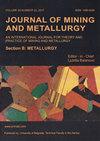研究了废食用油作为碳中性还原剂清洗过程中磨砂与炉渣的分离行为
IF 1
4区 材料科学
Q3 METALLURGY & METALLURGICAL ENGINEERING
Journal of Mining and Metallurgy Section B-Metallurgy
Pub Date : 2021-01-01
DOI:10.2298/jmmb210407034w
引用次数: 1
摘要
废食用油作为一种废弃物资源,尚未得到广泛的利用。根据WCO裂解的特点,本研究提出用WCO代替化石基还原剂清洗铜渣,以解决该过程中的碳中和问题。在实验室电炉上进行了铜渣净化实验。研究了磨砂在炉渣中的分离行为和磨砂在炉渣中的分布。结果表明:在300 g铜渣中注入2.2 mL WCO,在1250℃下,Fe3O4含量从12.9%下降到3.5 wt.%;渣中铜含量沿垂直方向呈梯度分布。在还原阶段,减少了过量的Fe3O4,提高了渣的流动性。当沉淀时间大于60 min时,中上渣中的铜含量降至0.57 wt.%,实现了WCO对铜渣的净化。本文章由计算机程序翻译,如有差异,请以英文原文为准。
Matte separated behavior from slag during the cleaning process by using waste cooking oil as carbon neutral reductant
As a waste resource, waste cooking oil (WCO) has not been widely used. Based on the characteristics of WCO cracking, this study proposed to replace fossil-based reductant with WCO for copper slag cleaning, to solve the problem of carbon neutralization in this process. Copper slag cleaning experiments were carried out in a lab-scale electric furnace. The matte separated behavior from slag and the distribution of matte in slag were studied. The results showed that the Fe3O4 content decreases from 12.9 to 3.5 wt.% by injecting 2.2 mL of WCO into 300 g copper slag at 1250?C. The distribution of copper content in slag is gradient along the vertical direction. In the reduction stage, the excessive Fe3O4 is reduced and the fluidity of slag is improved. When the precipitation time above 60 minutes, the copper content in the middle and upper slag is reduced to 0.57 wt.%, which realizes the copper slag cleaning by using WCO.
求助全文
通过发布文献求助,成功后即可免费获取论文全文。
去求助
来源期刊
CiteScore
2.00
自引率
40.00%
发文量
19
审稿时长
2 months
期刊介绍:
University of Belgrade, Technical Faculty in Bor, has been publishing the journal called Journal of Mining and Metallurgy since 1965 and in 1997 it was divided in two independent journals dealing with mining and metallurgy separately. Since 2009 Journal of Mining and Metallurgy, Section B: Metallurgy has been accepted in Science Citation Index Expanded.
Journal of Mining and Metallurgy, Section B: Metallurgy presents an international medium for the publication of contributions on original research which reflect the new progresses in theory and practice of metallurgy. The Journal covers the latest research in all aspects of metallurgy including hydrometallurgy, pyrometallurgy, electrometallurgy, transport phenomena, process control, solidification, mechanical working, solid state reactions, materials processing, surface treatment and relationships among processing, structure, and properties of materials.

 求助内容:
求助内容: 应助结果提醒方式:
应助结果提醒方式:


